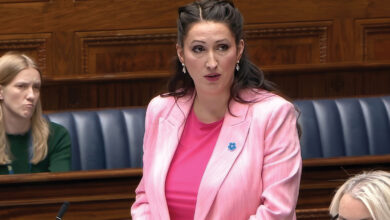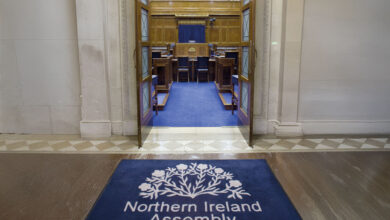The fiscal position in the early years of a united Ireland

While the northern economy is weak relative to the Republic, the cost of unity will be contingent on the speed of convergence with the Republic, writes John Doyle, professor in the School of Law and Government and Vice President of Research, Dublin City University.
Recent reports on the public finances of a united Ireland have estimated the transitional cost in a range from €400 billion to €25 billion over the first two decades of the new state coming into existence.
In evidence presented to the Oireachtas Joint Committee on the Implementation of the Good Friday Agreement, I set out why the recent Institute of International and European Affairs (IIEA) report which stated that the initial costs of a united Ireland would be €20 billion per annum over 20 years is wildly inaccurate, as the report contains significant errors and is based on entirely unreasonable assumptions.
The IIEA report is not a worst-case scenario; it is just wrong. There is insufficient room here to look at every element, but a few key highlights, indicate a very different outcome is much more likely.
The IIEA report adds over €4.2 billion per annum to the cost of unity, by increasing public sector wages to the levels in the Republic but makes no allowance for the taxes (which would be overwhelmingly at the higher rate of 40 per cent), PRSI (4 per cent) and pension contributions (typically around 10 per cent) to be paid on that increase.
Correcting this error reduces the real cost of salary increases by €2.2 billion per annum. There are similar difficulties with the IIEA’s welfare and pension estimates, and it makes no allowance for those increases being paid over some agreed period of time, as the costs of living also converge.
The IIEA report uncritically uses the published UK Government subvention figure of over £12 billion as the starting point for the fiscal balance of a united Ireland, half of which relates to debt and pensions. While the UK Government could legally cancel pensions, the question is whether it would be politically expedient to do so. No such threat was made for example during the Brexit negotiations, as regards UK officials who had worked for EU institutions, in fact a new post-Brexit agreement was signed with Ireland to maintain the cooperation on pensions and ability to move in either direction without loss of pension, which see thousands of Irish people receive UK pensions based on years of contributions in the UK.
The IIEA even assumes that if the UK Government abandoned such pensioners, including to military and police veterans, health workers and others, that the Irish Government would then volunteer to pay £2 billion per annum for UK state debt, for which it has no legal liability whatsoever.
There are also technical ways in which the UK allocates central UK expenditure outside of Northern Ireland to its various regions, or allocates taxes, which would reduce the transferred subvention very significantly. In the full report submitted to the Oireachtas Committee, a detailed analysis of the existing subvention shows that the opening deficit for Northern Ireland in a united Ireland, before any new policy decisions, would be just €1.5 billion, taking account of issues such as debt, pensions, defence, and tax changes.
Finally, the IIEA report excludes any analysis of economic growth during the 20 years after unity. It assumes that with the same political system, back inside the EU, and similar policy frameworks, education system and tax regime, that Northern Ireland would not economically converge with the Republic. This is a very unlikely outcome.
Why would Belfast continue to perform so much worse than counties Cork and Kerry with the same EU access, policies, education, and tax system? As a larger city, Belfast should do better and take pressure off the Dublin region. Likewise, Derry and the wider northwest should see economic benefits, with new investment and without the impact of the border.
The economy in Northern Ireland is weak. Wages are much lower than the Republic, educational outcomes are poorer, and waiting lists in the health system are much worse. Significant additional investment is therefore needed. However, it needs to be gradual to avoid creating massive inflationary pressures.
Allowing for an increase in public expenditure in Northern Ireland, of €1 billion in year one, to increase salaries and pensions, invest in education, and improve public services, would require Ireland to borrow three-quarters of 1 per cent of GNI* to cover that combined €2.5 billion per annum deficit – a readily affordable figure.

“The ongoing cost of unity will be determined by the rate of economic growth in Northern Ireland, and the speed of convergence with the Republic.”
John Doyle, Vice President of Research, Dublin City University
That investment into Northern Ireland would increase each year for some time as salaries increase, as the economy could absorb it and as the cost of pensions, for example, gradually transferred to Ireland, but it would also be gradually re-couped in tax revenues, as the northern economy begins to grow and to reflect the living standards and wage levels in the Republic.
The ongoing cost of unity will be determined by the rate of economic growth in Northern Ireland, and the speed of convergence with the Republic. In the last 20 years, the central European states joining the EU all experienced growth rates of between 1 per cent and 3 per cent per annum above EU averages, allowing for clear convergence in living standards with the western states.
If the currently weak Northern Ireland economy began to converge with the Republic, with growth of 2 per cent per annum above its post Good Friday Agreement experience inside the UK, this would cover the costs of transition – including increasing public sector salaries, state pensions, and welfare payments – and end the fiscal deficit in approximately 10 years, after which the North would run a surplus.





